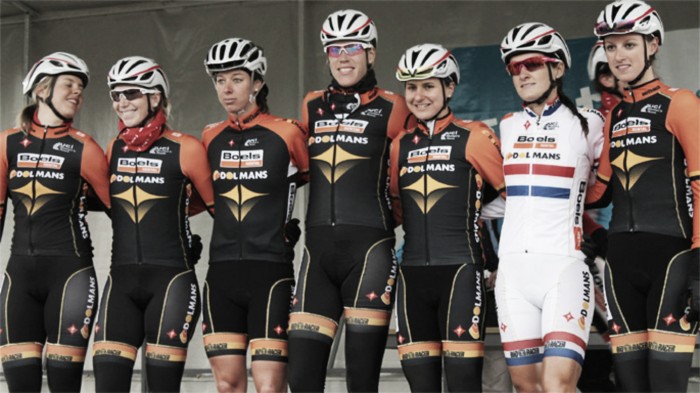As of September 2015, the UCI announced the launch of a new women's WorldTour to replace the Road World Cup which has been in existence since 1998.
The WorldTour consists of a series of top races for professional women, with a total of 17 races set over 35 days from March to September. In comparison, the recently replaced World Cup only took ten days from the cycling season.
The new series will include a mixture of one-day and stage races, bettering the ten one-day races of the previous World Cup, with most of which having moved over to the longer sequence of races.
Rules and regulations
Under new regulations, maximum stage distances rise by ten kilometres from 130km to 140km, with the average stage distance being between 100km and 120km.
The longer stages combined with increased media coverage mean prize money has risen, with minimums being introduced: €5130 for one-day races and time trials, and €2565 per day for a stage race.
As previously, teams for a one day race must consist of up to six riders, with no fewer than four. Stage races should have a maximum of eight - seven in some - with no less than five. The points available for winning overall in one-day or stage races remains 120, with 25 points available for stage and half-stage winners. The leader of a race will get six points for every day in the lead, while the overall WorldTour leader will get six points every day they retain the rainbow jersey.
Boels Dolmans dominate standings
The Strade Bianche (Italy) set the wheels of the WorldTour rolling in only it's second edition, with World Champion Lizzie Armitstead securing her Boels Dolmans team fourth road win of the year. Her victory in Siena came with the honour of being the first person to wear the Women's WorldTour jersey, as well as being the last person to win the World Cup series jersey.
Armitstead has since returned to Italy for the Trofeo Alfredo Binda in which she reclaimed the rainbow leaders jersey from Boels Dolmans teammate Chantal Blaak who had won the previous Ronde Van Drenthe in her native Netherlands.
Blaak then won the fourth race, the Gent-Wevelgem (as part of the Flemish cycling week), to ensure the unstoppable Dutch team clutched four wins in four World Tour appearances, and eight for the season.
So, with 13 stages left, and the exhilarating Tour of Flanders starting on April 3rd, we look to see if the recently imposed Women's WorldTour is beneficial for women's cycling on the whole.

Media coverage and advertising
The initial announcement of the introduction of the WorldTour this year came with some encouraging news for women's cycling; a guideline was set in place by the UCI stating that all race organisers that become involved with the series must provide promotional media. These organisers are expected to provide live TV,ing or a highlights package among other promotional media.
All races will be broadcast live on UCI's YouTube channel, one that has over 180,000 subscribers and over 100,000 video hits per month. This widely used social platform is sure to boost the status of the rising women's cycling scene.
Kristy Scrymgeour, owner of recently folded Women's UCI team Velocio-SRAM believes this increased media coverage will provide "a lot of positive changes", with teams being able to benefit from more sponsors who will "give a bigger return in their investment."
Longo Borghini sets equal ambitions
Holding Tour of Flanders winner Elisa Longo Borghini (Wiggle High5) believes that the introduction of the women's WorldTour will bring more equality to the women's side of the sport, with her "dream" being that the "women's cycling is as professional as the men's."
The women's WorldTour will effectively try to mirror the already existing men's WorldTour which was founded in 2009. However, after several breakthroughs in the past three seasons, in terms of their calendar, the introduction of this series has been the first major step forward for the female peloton in many senses.
"For me, it is emotional thinking of a WorldTour" reveals the 23 year-old, who also admits that she would love to "ride the Tour de France" and see the women's edition reintroduced in order to promote the sport more.
The governing body looks to turn the sport into a much more professional and sustainable model by controlling team registration and licenses in 2017, but it's 2018 that will prove an even greater step in the sport's gender equality, with each team having full time staff, and the "financial structure similar to a men's team" explains the Italian.
Borghini later explains the new sponsorship concept put in place for the WorldTour, as she believes many teams "may find it hard to go to the WorldTour" due to the much greater coverage and pressure, but believes it will be incredible "for the development of the sport."
Deserved progress for women's cycling
The newly imposed women's WorldTour is really a great platform for the sport to progress in terms of coverage, professionalism, and most importantly, equality.
The increased funding and promotion from sponsors and the UCI will allow women's cycling to push forward in the near future, with the introduction of professional team staff and increased wages to match the men's seeming more and more likely.









































